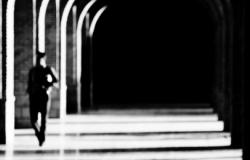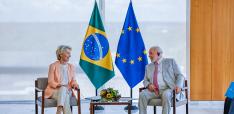Future Challenges Faced by Iran

Meir Javedanfar explores Iran's challenging future. This is a chapter from the e-book 'The Future of the Middle East' co-produced by Global Policy and Arab Digest, and edited by Hugh Miles and Alastair Newton. Freely available chapters will be serialised here and collected into a final downloadable publication in the spring.
In the short to medium term, the biggest threat emanating from inside Iran which should concern the international community is increased factionalism and factional infighting.
Why should the international community care about factional infighting in Iran? After all, this is a domestic, internal matter for Iran and its politicians. Such an answer is correct, but only partially. In Iran, foreign policy, especially Iran's behaviour towards other countries, is greatly impacted by domestic political developments within the country.
The three ‘Rs’ — Republicans, Reformists and Revolutionaries
The main factions in Iran today are the Republicans and the Revolutionaries. The former, a majority of whose members belong to the moderate camp of Iranian politics, believes that 37 years after the revolution, Iran should now normalise and focus on its “Republic”, meaning domestic issues such as unemployment, poverty and corruption. This is in addition to focusing on dialogue with the international community including the West, instead of confrontation.
The current political leader of this faction is President Hassan Rouhani himself, while the political Marja-i Taqlid (source of emulation) for this movement is former president Ali Akbar Rafsanjani (1934-2017). They both believe in reducing tensions with both the West and Iran's regional neighbour Saudi Arabia. They even believe that Iran should also reduce tensions with Israel. In an amazing, yet largely un-noted, speech September 2015, President Rouhani is reported to have stated to a group of Islamic Revolutionary Guard Corps (IRGC) officers: “Today, the main enemy of the Islamic Republic of Iran is not America and Israel, rather it is unemployment, inflation, sandstorms, lack of water and the environmental disaster facing the country, for which we have to urgently think of solutions and to apply them”. In the context of Iranian politics, this is a monumental statement to make by any Iranian president, and even more important that he made in front of a group of senior IRGC officers.
The Reformists, who saw their power greatly diminish within Iran's political balance of power after the 2009 uprising, are aligned with the Rouhani/Rafsanjani so called “moderate” faction.
The Revolutionaries, a majority of whose members belong to the Conservative camp of Iranian politics, believe that Iran must remain true to its revolutionary goals of 1979, meaning first and foremost focusing on the fight against the US, as well as the Saudis and Israel whom they consider as American ‘puppets’. According to Hujatulislam Ali Saidi, should Iran stop being a revolutionary state, it could meet the same fate as the USSR, ie it could collapse. According to this appointee of the supreme leader to the all-important IRGC, the USSR collapsed the moment it started its rapprochement with the US, instead of following its revolutionary anti-American path as it had done previously. The same could happen to Iran.
The head of the revolutionary camp in Iran is the supreme leader himself, Ayatollah Ali Khamenei; he is followed by the head of the IRGC, Mohammad Ali Jaafari, and the leaders of other important factions such as the Principalist Osulgarayan, as well as the head of both the powerful Guardian Council and the Assembly of Experts Ayatollah Ahmad Jannati.
Nuclear deal deepens the divide domestically…
These two camps clashed over Iran's nuclear strategy well before the 2015 Joint Comprehensive Plan of Action (JCPOA) was finalised. However, they are likely to clash even more in the wake of the deal. An important reason behind this is the expected uptick in the economy, or foreign investment to be exact. For the foreseeable future, the IRGC, mainly its massive Khatam Al Anbiya business conglomerate, will have to watch foreign business invest in Iran, while avoiding dealings the IRGC and its companies like the plague. The reason? Existing sanctions. Foreign companies understood fully, even before the change of Administration in Washington earlier this year, that if they invest any any IRGC companies or its affiliates, they could — almost certainly would — incur the wrath of the US Treasury department with inevitable damaging consequences. So, while other non-IRGC companies, which will most probably also include Rafsanjani-affiliated companies, enjoy foreign investment and all the financial and technological benefits that go with it, the IRGC will be left out. This is likely to increase resentment and conflict between the Republicans who are currently in charge of the government, and the Revolutionaries who are in charge of the most important institutions of the regime. Rouhani's outreach to the Revolutionaries by recently awarding an important energy project to a supreme leader affiliated company is unlikely to reduce tensions between the two sides.
 The other factor which is likely to increase the infighting even more is the upcoming presidential election of 19 May 2017. It seems that the Conservatives do not have a candidate who could beat Rouhani. One of their best bets was the current Tehran Mayor Mohammad Baqer Qalibaf; but he recently became embroiled in a massive corruption scandal where the Tehran municipality which he heads was accused of selling real estate to corrupt officials at a 50% discount. The other heavyweight candidate was the current speaker of the Parliament Ali Larijani, but he recently announced that he won't be running. Meanwhile former president Mahmoud Ahmadinejad (who also, some believed, could be a contender for the conservatives) was told by the Supreme Leader not to run as his campaign could “divide the country”.
The other factor which is likely to increase the infighting even more is the upcoming presidential election of 19 May 2017. It seems that the Conservatives do not have a candidate who could beat Rouhani. One of their best bets was the current Tehran Mayor Mohammad Baqer Qalibaf; but he recently became embroiled in a massive corruption scandal where the Tehran municipality which he heads was accused of selling real estate to corrupt officials at a 50% discount. The other heavyweight candidate was the current speaker of the Parliament Ali Larijani, but he recently announced that he won't be running. Meanwhile former president Mahmoud Ahmadinejad (who also, some believed, could be a contender for the conservatives) was told by the Supreme Leader not to run as his campaign could “divide the country”.
The absence of a viable candidate to take on Rouhani could mean that the Conservatives could instead switch to the strategy of making life as difficult as possible in the immediate run-up to the elections in order to make him look like a lame duck. Such a strategy could gain strength if Rouhani wins, as was the case when Reformist former President Mohammad Khatami won his second term in 2001, meaning more obstacles could be placed in Rouhani’s way to implement his policies.
…and on regional policy
An important consequence of such tensions could be Iran's policies in the region, especially with regard to Syria, Iraq, Yemen, Lebanon and Israel. The Revolutionaries know that the Republicans want to reduce tensions on all these fronts, in order to increase foreign investment into the ailing economy. The latter also know that they have the people behind them. An important sign showing how isolated the Revolutionaries’ regional policies, especially those regarding Syria, are among the people of Iran is that no public criticism of Assad (or Hamas and Hezbollah) is allowed. A clear example was seen in 2013 when Ayatollah Rafsanjani mentioned Assad's use of Chemical weapons. His comments were soon altered by the official news agency which had reported them.
And this is where the international community should worry. Realising how moderates want to ease tensions with the US and Saudi Arabia, in order to isolate them at home, the Revolutionaries have been and will continue to do the opposite, ie look further to inflame tensions. Some of the Conservatives openly accuse Reformists of backing the Syrian opposition and thus see the war in Syria as a war against the “seditionists” of the 2009 Green uprising as well.
Consequently, even though Iran has other strategic reasons behind its current regional policies (such as helping Assad to stay in power in order to maintain its supply routes from Syria to Hezbollah forces in Lebanon), domestic tensions in Iran also play an important part in its current regional strategy. And they will continue to do so for the short- to medium-term. How can we expect otherwise when the Supreme Leader himself has stated openly that he has requested that a “Revolutionary” figure is chosen as his replacement. Similarly, he requested the Assembly of Experts, which is in charge of choosing his successor, “to stay revolutionary, to think revolutionary and to act revolutionary”. The Supreme leader stated that ensuring these characteristics in choosing his successor is one of the most crucial tasks of the Assembly, meaning that the Revolutionary front will continue to rule over the Republicans and to challenge them during the current and, most probably, the future supreme leader's term.
Water-related risks
One of the the biggest long-term challenges which Iran is facing which the international community should take note of is the drought. Again, although this is an internal matter, it will have consequences on Iran's long-term strategy and behaviour in the region.
The Middle East is becoming drier. Iran is not alone in facing the drought challenges which numerous countries in the region are facing. However, the seeming lack of preparation, and the deteriorating situation, make it a problem of significant magnitude.
The alarms are ringing all over Iran regarding the impact of the drought. One recent warning was from Dr Isa Kalantari, chief adviser on water, agriculture and environmental affairs to Iran’s current deputy President Eshagh Jahangiri. According to him, should the status quo regarding Iran's drought continue, “approximately 70% of Iran’s total population, meaning the equivalent of a 50 million population, could be forced to migrate abroad in order to stay alive”.
Let’s say his assessment is greatly exaggerated and only a tenth of the population in Iran has to move abroad for the search of water. That’s still five million Iranian. Who will host them? Afghanistan? Iraq? Turkey? Which regional country will have the resources to host such a large population, when all of Iran's neighbours are struggling with their own economic as well as environmental challenges? And if they don't accept them, what will happen then? The problem of internal migration is one which is already confronting Iran. Some of the population of cities such as Zabol in Iran's Sistan and Baluchistan region, are already abandoning their homes and possessions because of the drought and migrating elsewhere. This is in addition to 200 villages in the same province whose population also migrated because of water issues.
The capital city of Tehran could only take a limited number of water refugees, as it is facing its own water and pollution challenges. And there is an even more daunting related challenge: parts of the city are are grappling with sinkholes. This problem is created by illegal water drilling and water wells which are extracting below-the-surface water resources, thus making the ground above more susceptible to sinkholes. There have already been a number of sinkholes appearing in the middle of Tehran. In a recent conversation with the E’etemad newspaper, the head of the housing commission for Tehran stated that one major sinkhole has been appearing in the streets of Tehran every month. Meanwhile some of the homes in Tehran's Shahr-e Rey neighbourhood are having to be sold because of cracks created by land subsidence.
The problem of subsidence is also affecting the areas around Tehran. The plains around Tehran called Dasht-e Tehran, have subsided by as much as 36 centimeters. According to Javad Meybodi, Director of Water and Wastewater Systems Utilization and Protection of Water at the Ministry of Energy, this is a world record. The other concern for Tehran is that if there is an earthquake, its damage will be magnified by the land subsidence problem. This is a valid concern as Tehran sits on an earthquake fault line.
Meanwhile moving to other major Iranian cities is unlikely to offer much of a solution as they are also facing their own environmental problems, including land subsidence challenges. According to the Ministry of Energy’s findings, the Qazvin fields situated around the city of Qazvin, population 1.2 million people, have subsided by 24 centimeters. Meanwhile the surrounding desert area around the city of Mashhad, home to 2.7 million inhabitants, has subsided by 25 centimeters, while the desert fields around the city of Kashan have subsided by 30 centimeters. These are important open areas surrounding some of Iran’s major urban population centres. According to some estimates land subsidence is impacting 297 fields and deserts around Iran. The general physical instability and, at times, the sinkholes created by such subsidence mean that such areas can no longer be used for agriculture or construction purposes.
The Rouhani government has taken a number of initiatives to address the problem of drought. These include signing an agreement with the German Consortium inter 3 in 2013 to manage Iran's water resources. This is in addition to plans to work with French and South Korean companies to reduce water wastage.
However there are grave concerns as to whether these will be sufficient to address what is a monumental challenge facing Iran's long term future, one which could and most probably will impact how Iran sees itself and its role in the region in the long-term. These massive challenges posed by the drought could have two consequences in this area: they could make Iran look more inward, or more outward and aggressive than before.
Considering the case for greater inwardness, many of the drought affected areas are situated around its borders where many of the minorities live. This could mean inflaming existing tensions in such areas. The Arab residents of Khuzestan province, where most of Iran's Arabs live, have already seen such tensions. In fact, some Arab residents of the province have dubbed the Karkheh damn which has reduced the water flow of Karkheh river in that province as the “Arab Killer” damn. Furthermore, major migrations within Iran because of the drought could create economic as well as security-related strains on Iran's economy and security services as massive migrations could create tensions between residents and migrants. Such challenges could mean that Iran will have to dedicate much of its security and economic resources inwards, instead of elsewhere in the region.
Alternatively, such challenges could encourage Iran to take a more aggressive stance abroad in order to direct attention away from domestic challenges at home. A case in point is that of Pakistan: although the country is facing massive water challenges, which some believe is a threat bigger than the threat posed by militancy, in addition to an energy crisis, nevertheless it continues to challenge its neighbours in Afghanistan and India.
Between these two scenarios, the scenario that Iran may in fact become more aggressive in the region because of its drought related challenges is one which is very realistic and one which all countries in the region, especially Iran's immediate neighbours as well as its regional rivals, have to take into consideration. One thing which this region has taught us is that lack of resources creates tensions between neighbouring countries, even if the challenges are exacerbated by domestic mismanagement.
Economic drivers
Last but not least, the other long-term challenge faced by Iran is that of its economy. The world is already trying to reduce its dependence on fossil fuels. This is a trend which is likely to gather strength over the next 20 – 30 years. Oil and gas constitute Iran's biggest exports. Meanwhile Iran's economy continues to be weighed down by massive corruption and mismanagement, a problem which is unlikely to be resolved in the near- or long-term future. So, while its regional neighbours such as Saudi Arabia embark on a massive privatization campaigns and invest in a $100 billion technology fund with the Japanese firm Softbank, the question remains: what is Iran doing to prepare for its economic future?
With dwindling water resources, it could face serious challenges in this area as agriculture products make up an important part of its non-oil exports. Should its tensions with the West continue, investing in massive funds like Saudi Arabia, Kuwait and Qatar will prove to be difficult. Meanwhile should its notable ‘brain drain’ problem, as well as its strained relations with the Iranian diaspora community, continue in its current format, a scenario which is quite probable, it will be more difficult for Iran to develop an indigenous, export driven high tech industry similar to that of Israel. Such uncertainties regarding Iran's economic future, and more importantly, the seeming lack of planning mean that the scenario that Iran will in fact be a poorer country in the region than it is now is one which is realistic.
Such a scenario could also impact Iran's policies in the region. An economically poorer Islamic Republic, with fewer water resources and at the same time free to develop its nuclear industry once major restrictions are lifted 15 years after the current nuclear deal could mean that the Islamic Republic may project its power abroad with more vigour.
The next supreme leader?
This is especially true if the country continues to be ruled by the Revolutionary front in its politics, rather than the Republicans. A quick look at all suggested replacement candidates for the role of supreme leader suggest that this is likely to be the case. Ayatollahs Shahroudi, Sadegh Larijani, the newly anointed 'Ayatollah' Seyyed Ibrahim Raisi, as well as Khamenei's own son Mojtaba who some believe could also be a viable candidate, all belong to the Revolutionary wing.
The only Republican candidate who some believe also has a chance is current president Hassan Rouhani. His chances of being elected to this role are low, as all presidents who have served under Ayatollah Khamenei's term as Supreme Leader have subsequently fallen out with him, and the all-powerful Revolutionary Guards. The need for good relations with the IRGC is likely to have a strong impact on the selection of Iran's next supreme leader leader. Judging by its current strained relations with President Rouhani which have only gotten worst since his election in 2013, his chances of being elected supreme leader do not seem to be very high.
Meir Javedanfar teaches Iranian politics at the Interdisciplinary Center (IDC) in Herzliya. He is also a researcher at the Meir Ezri Center for Iran and Persian Gulf Studies at the University of Haifa.


